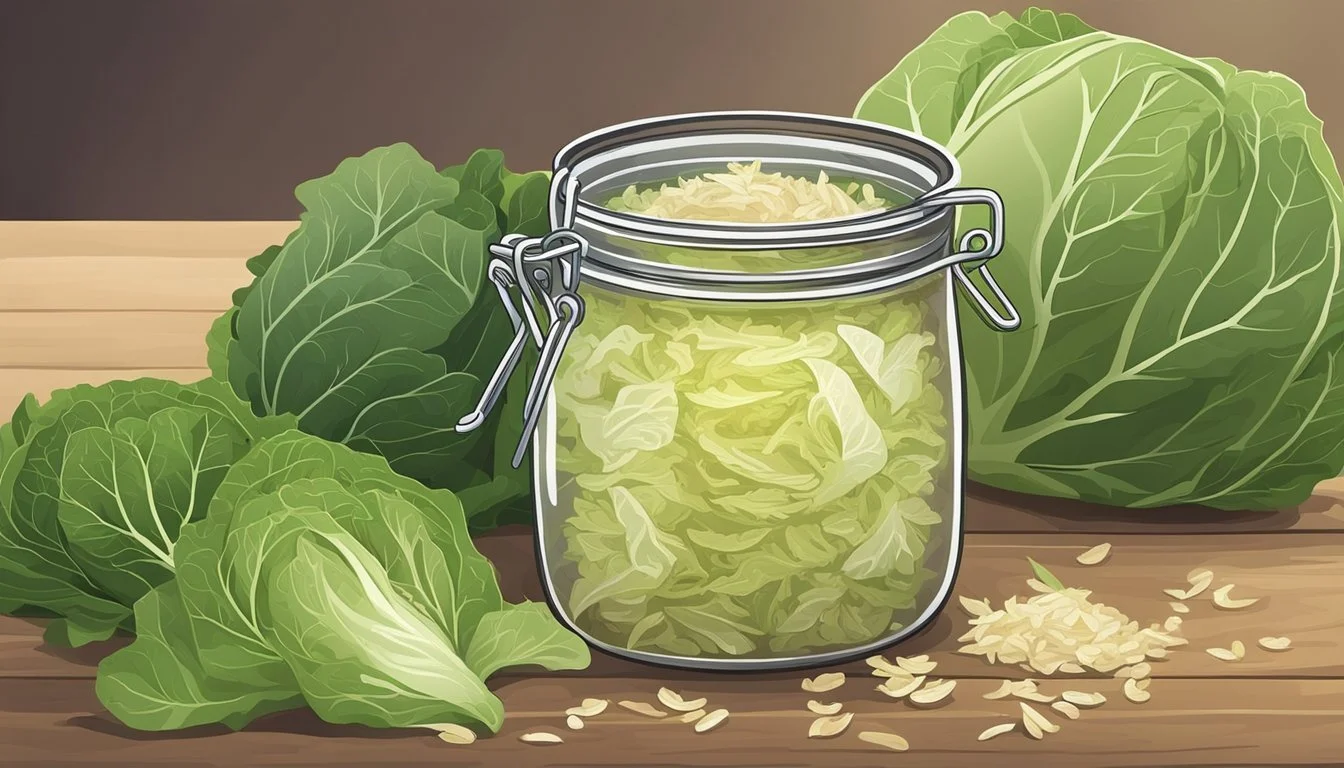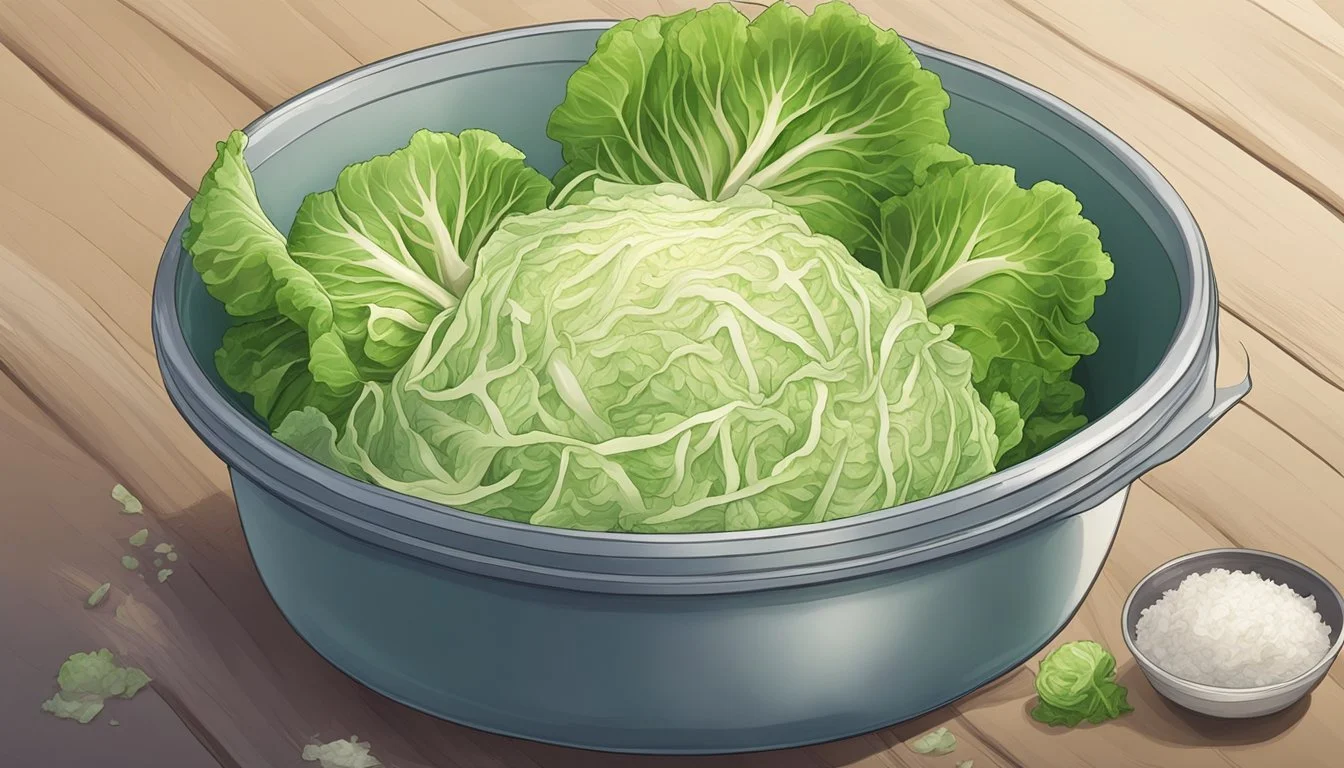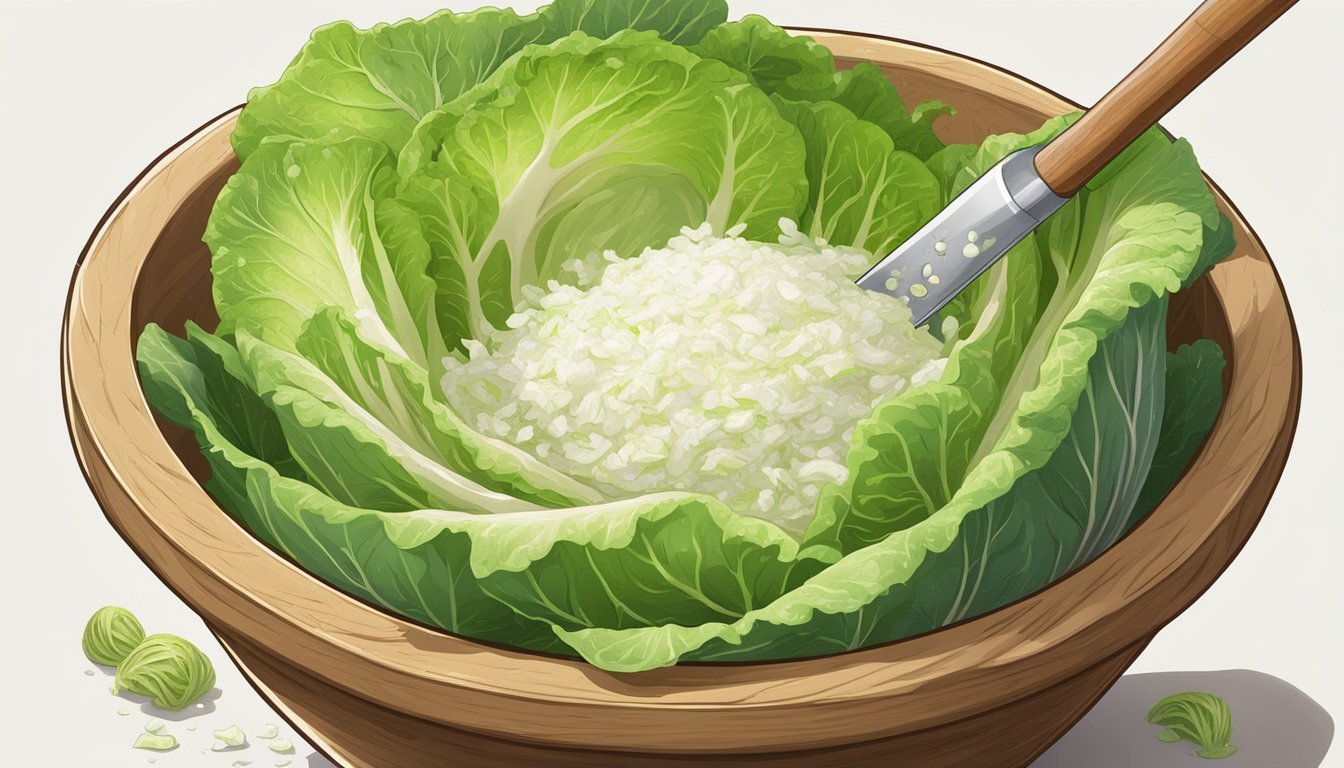How to Make Sauerkraut and Why it's Good for You!
Discover > Healthy Living Through Food > How to Make Sauerkraut and Why it's Good for You!
Sauerkraut, a traditional dish of fermented cabbage leaf, has been a staple in many cultures for centuries. This simple yet powerful food is created through the process of lacto-fermentation, where natural bacteria feed on the sugar and starch in the fresh cabbages, transforming it into lactic acid. This not only preserves the cabbage leaf, significantly extending its shelf life, but also enriches it with lactic acid bacteria, probiotics, vitamins, and minerals. The distinctive tangy flavor or pleasant pickle flavor of sauerkraut is celebrated in cuisines around the world, and it can be served as both a side dish and a condiment.
The health benefits of homemade sauerkraut are extensive. It supports digestion, promotes a healthy immune system, and may reduce the risk of certain diseases. The probiotics generated during fermentation are beneficial for gut health, improving the balance of bacteria in the digestive system. These live microorganisms can aid in the absorption of nutrients and bolster the body’s defenses against infections. Additionally, sauerkraut is low in calories and high in fiber, making it an ideal food choice for those looking to maintain a healthy diet.
But before going into what makes sauerkraut what it is, it's interesting to look into how sauerkraut came to be. A look into history holds how rich the pedigree of this delectable side dish and snack has been through the centuries.
The Origins and Health Benefits of Sauerkraut
Sauerkraut has its origins in ancient China, where it is believed to have been a staple diet of laborers building the Great Wall over 2,000 years ago. In the past, the Chinese fermented the raw outer leaf of cabbage heads in rice wine. Eventually, it made its way to Europe, where it was embraced for its long shelf life because of the acid fermentation and nutritional value, especially during long sea voyages. And, because of the presence of beneficial probiotics and rich amounts of Vitamin C, sailors in ancient antiquity discovered that it helped immensely in preventing scurvy.
Nutritional Benefits of Sauerkraut
Sauerkraut is low in calories but high in vitamins such as Vitamin C, folate, and vitamin B6. It is also a good source of fiber and iron. You can expect that a cup of sauerkraut contains the following nutrients of vitamins:
Vitamin C: Essential for healthy skin and immune response.
Iron: Critical component for blood production and maintaining good blood pressure.
Fiber: Because of the cabbage, sauerkraut is a great source for fiber that supports digestive health.
Potassium, another beneficial element found in sauerkraut, helps regulate fluid balance and nerve signals.
Sauerkraut and Digestive Health
As a fermented product, each batch of raw sauerkraut is rich in probiotics, the beneficial microorganisms that populate the gut. These probiotics help maintain a healthy balance of gut flora, which is crucial for optimal digestion and for fighting against harmful pathogens.
Sauerkraut's Role in Immune Support
The immune system is strongly influenced by the health of the gut microbiome, where a significant portion of the immune cells reside. The rich supply of Vitamin C and probiotics in sauerkraut supports the immune system, potentially reducing the risk of chronic diseases, including certain types of cancer.
Essential Ingredients for Making Sauerkraut
Making sauerkraut at home is a straightforward process that requires only a few simple ingredients: a head of cabbage, salt, and time. The fermentation occurs naturally at room temperature and does not require any special equipment like food processors. Once fermented, sauerkraut can be stored for several months in a cool, dark place, allowing you to enjoy its probiotic benefits long after the cabbage season has ended. The technique of fermenting cabbage to create sauerkraut is both an art and a science, honed through generations of tradition and supported by modern nutrition science.
Choosing the Right Cabbage
The type of cabbage selected sets the foundation for sauerkraut. Green cabbage is most commonly used for its balance of sugars and firmness, which facilitates a steady fermentation process and a crisp texture. For variety, one may also use red cabbage, which contains higher levels of Vitamin A and gives the final product a vibrant hue.
The Importance of Salt in Fermentation
Salt is crucial as it draws moisture out of the cabbage and creates an environment where beneficial bacteria thrive while inhibiting harmful ones. Two types of salt are preferred:
Sea salt: Rich in trace minerals, contributing to the sauerkraut's flavor and nutritional profile.
Kosher salt: Sauerkraut can also use kosher salt with its brine because of the absence of iodine.
Pickling salt: Pure and fine-grained, ensuring a clear brine without added anti-caking agents.
Optional Additives for Flavor and Nutrition
While not essential, additional ingredients can be added to sauerkraut to tailor its flavor and boost its nutritional content:
Caraway seeds: Provide a distinctive earthy flavor that complements the tanginess of sauerkraut.
Garlic: Adds depth and pungency to the flavor profile.
Herbs: Such as dill or thyme, for aromatic notes.
Carrots: Introduce subtle sweetness and additional texture.
These optional additives not only enhance the flavor but can also introduce additional vitamins and nutrients, making the sauerkraut even more beneficial to one's diet.
Preparing Your Kitchen for Sauerkraut-Making
Before embarking on the sauerkraut-making process, ensuring that your kitchen is armed with the right equipment and maintained in a state of cleanliness is crucial. Adequate preparation sets the stage for a successful fermentation process.
Selecting the Proper Equipment
The first task in preparing to make sauerkraft is gathering all the necessary equipment. A fermenting crock or canning jar serves as an ideal container for fermenting sauerkraut. If unavailable, a mason jar can be used as a substitute. It is essential to have weights like glass disks or clean stones to keep the cabbage submerged in its brine. The use of a sauerkraut tamper or potato masher can aid in compressing the cabbage to release its juices. A mixing bowl is required for initially mixing the cabbage with salt before transferring it to your fermentation vessel.
Container: fermenting crock, canning jar, or mason jar
Weights: glass weights or clean stones
Tools for Compressing Cabbage: sauerkraut tamper, potato masher
Mixing Equipment: large mixing bowl
Understanding the Importance of Cleanliness
Cleanliness is paramount when making sauerkraut to prevent contamination and ensure a safe fermentation process by removing the possibility of growing bad bacteria. All equipment, including the chosen containers (i.e. wide mouth mason jars), weights, mixing glass bowls, and compression tools, must be sterilized. This can typically be achieved by washing with hot, soapy water and then rinsing them thoroughly. Drying everything completely before use is equally important to inhibit unwanted bacterial growth. Covering the fermenting sauerkraut with a cloth protects it from dust and insects while allowing the necessary airflow. Ensuring that every component that comes into contact with the sauerkraut is clean will contribute to the successful fermentation of a healthy, probiotic-rich batch.
Sterilization: Wash and rinse equipment thoroughly to ensure the whole process is free from harmful bacteria.
Drying: Ensure all tools and containers are dry before use.
Covering: Use a cloth to cover the fermenting sauerkraut.
The Sauerkraut Fermentation Process
The sauerkraut fermentation process leverages natural bacteria to convert sugars into lactic acid, a preservative that gives sauerkraut its distinct sour flavor.
The Science Behind Fermentation
Fermentation is a metabolic process in which natural bacteria feed on the sugars and starches in cabbage, producing lactic acid. Specifically, in sauerkraut, Lactobacillus bacteria are the primary agents of fermentation. These bacteria thrive in an anaerobic (oxygen-free) environment, which is achieved when the cabbage is submerged in brine. The ideal temperature range for sauerkraut fermentation is typically between 65°F and 75°F (18°C - 24°C). During this process, carbon dioxide is released and white scum may form at the top; this is a normal byproduct and can be skimmed off.
Step-by-Step Fermentation Guide
Prepare the Cabbage: Shred around a pound of cabbage and mix with salt to begin pulling out moisture.
Create the Brine: Through massaging and squeezing the cabbage, the salt draws out the water to create a natural brine.
Pack the Cabbage: Tightly pack the cabbage into a clean fermentation container and make sure you eliminate all air pockets in the container. This is to minimize air exposure and minimize the chances of spoiling it during the fermentation time.
Submerge Under Brine: Ensure the cabbage is fully submerged under the brine to create an anaerobic environment.
Seal and Store: Seal the container and store it at the appropriate temperature range (65°F - 75°F, or 18°C - 24°C) for the bacteria to work effectively.
Monitoring the Fermentation Stages
The sauerkraut fermentation process can be monitored through several stages:
Initial Stage (Days 1-3): Bacteria begin the fermentation process. The mixture should be kept out of direct sunlight and checked to ensure that the cabbage remains submerged.
Active Fermentation (Days 4-14): Bubbles and pressure may build due to carbon dioxide production; brine might seep out. It's important to "burp" the container if using an air-tight seal to release pressure.
Maturation (2-6 Weeks): The sauerkrait's flavor develops during this stage. The longer it ferments, the tangier it will become. Taste test can dictate when to stop the fermentation.
Preservation (After Maturation): Once the desired flavor is achieved, refrigerating the sauerkraut slows down the fermentation process, preserving it for consumption.
Finishing Touches: Curing and Flavoring Sauerkraut
Achieving the optimal balance of sour and complex flavor in sauerkraut requires a careful curing process and the addition of select spices. Proper storage ensures the fermented product maintains its quality.
Curing Sauerkraut for Better Flavor
The curing phase is critical for developing the sauerkraut's desired sour taste. After initial fermentation, fermented sauerkraut should be kept at a stable temperature away from direct sunlight. This can take place over a few weeks to several months. Storing sauerkraut in a cellar or a special fermenting space with an airlock system ensures a controlled environment, allowing the flavors to mature and the beneficial bacteria to thrive.
Adding Spices and Other Flavorings
To enhance the sauerkraut's flavor profile, adding spices during the initial mixing or toward the end of fermentation is an option. Common spices include:
Caraway seeds
Juniper berries
Dill
These should be used sparingly as they can overpower the natural flavors of the fermented food. Additionally, other flavorings like garlic, onion, or shredded carrots can be combined with the cabbage for a unique twist.
Storage Solutions for Sauerkraut
Once the sauerkraut has achieved the desired flavor, it should be stored properly to preserve freshness and extend shelf-life. The options include:
Refrigerator: Place the sauerkraut in airtight containers and store in the fridge for up to several months.
Canning: For longer storage, canning sauerkraut is a viable method. Sealed jars can be stored in a cool, dark place and, if done correctly, can last for a year or more.
Cellar: If available, a cellar can be an ideal storage location as it provides a consistent cool temperature and humidity level.
Storing sauerkraut in these conditions will keep it safe for consumption and maintain its nutrient content.
Serving and Cooking with Sauerkraut
Sauerkraut can be more than just a side dish; it serves as a versatile ingredient that can enhance a variety of recipes. Its tangy flavor makes it an excellent addition as a condiment or integrated into dishes across different cuisines.
Sauerkraut as a Condiment
Sauerkraut, with its distinctive tartness, can elevate the taste of many everyday foods. It pairs especially well with:
Sausages and hot dogs: A classic combination where the zesty kick cuts through the richness of the meats.
Sandwiches and wraps: A spoonful can add crunch and zest, making for a more complex flavor profile.
Burgers: Both meat-based and plant-based burgers benefit from sauerkraut’s juicy and sharp taste.
These pairings benefit from sauerkraut's probiotic qualities, turning simple meals into gut-friendly feasts.
Integrating Sauerkraut into Recipes
Sauerkraut can be cooked into a variety of dishes, contributing both flavor and nutrition. Chefs often use it in:
Stews and soups: It can introduce a layer of depth and can meld well with meats and vegetables.
Casseroles: It contributes a tangy dimension that balances out creamy and savory components.
Pasta dishes: A small amount mixed into a pasta sauce can offer an unexpected twist.
Sauces and dressings: Finely chopped sauerkraut can be stirred into sauces or dressings for a flavor boost.
Variations of sauerkraut, such as those with added caraway seeds or juniper berries, can provide additional flavors to recipes. It's essential to add sauerkraut near the end of the cooking process to preserve its probiotics and to maintain some crunch. Sauerkraut turns everyday cooking into a culinary experience with both delicious taste and health benefits.
Troubleshooting Common Sauerkraut-Making Problems
In the journey of fermenting sauerkraut, encountering problems like mold growth or taste and texture issues is not uncommon. Understanding how to address them ensures the sauerkraut is both delicious and safe to consume.
Dealing with Mold and Yeast
Mold Formation:
Visibility: Mold typically presents as a fuzzy, colored substance atop your sauerkraut or on the surface of the brine.
Prevention: To prevent mold, ensure the cabbage is fully submerged in the brine. Using a weight can help keep the cabbage beneath the liquid, reducing exposure to air which can introduce mold spores.
Solution: If mold appears, remove it immediately along with any sauerkraut that was in direct contact. The remaining sauerkraut that was under the brine is usually still safe to eat.
Yeast Growth:
White yeast, also known as kahm yeast, may form on the surface of the brine. This yeast is typically harmless but can impart an off-flavor.
To manage kahm yeast, skim it off the brine as soon as noticed, and check that the sauerkraut remains fully submerged. If the flavor is negatively affected, it's best to discard the batch to ensure quality.
Adjusting for Taste and Texture Issues
Sodium Level:
Sauerkraut recipes may vary in sodium content. If your sauerkraut tastes excessively salty, rinse it under cold water before consuming.
If it lacks flavor, consider adding more salt to future batches in increments, as salt is essential for preserving and fermenting.
Texture:
Soft Sauerkraut: For crisper sauerkraut, one might ensure that the cabbage is fresh and firm to start, and the fermenting process occurs at cooler temperatures.
Dry Sauerkraut: If the sauerkraut seems too dry, ensure adequate brine is covering the cabbage. Adding small amounts of salt water may help absorb into the cabbage and create more brine.
Remember, the key to successful sauerkraut is keeping the cabbage submerged in brine, managing the fermenting environment, and adjusting your recipe as needed based on the results.
The Longevity of Sauerkraut: Preservation and Storage
Proper storage is pivotal for maintaining the quality and extending the shelf life of sauerkraut. It ensures that the desirable flavors and beneficial bacteria are preserved over time.
Sauerkraut Storage Best Practices
To maximize the shelf life of sauerkraut, it should be kept in an airtight container such as a mason jar or glass canning jar. The refrigerator lends itself as the best environment for storage, maintaining a consistent temperature that slows the fermentation process while keeping the sauerkraut crisp. List of Best Practices:
Container: Seal sauerkraut in a clean, airtight container.
Temperature: Store the sauerkraut in the refrigerator between 35°F to 40°F.
Avoid Contamination: Always use clean utensils when serving sauerkraut to prevent contamination.
Keep It Submerged: Ensure the sauerkraut is covered by its liquid to reduce the risk of mold.
Extending Sauerkraut Shelf Life Through Freezing
Sauerkraut can be frozen to extend its shelf life further. However, this may alter its texture. Freezing should be done in freezer-safe containers, leaving some headspace for expansion. To use, simply thaw in the refrigerator before consumption. Freezing Guidelines:
Container: Use freezer-safe containers such as freezer bags or rigid glass containers.
Portioning: Freeze in small portions to avoid thawing more than needed at one time.
Headspace: Allow for about 1/2 inch of headspace in the container to accommodate expansion.
Thawing: Thaw sauerkraut in the refrigerator to preserve its quality.










